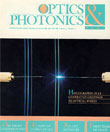
July 1990 Issue
Feature Articles
Holographically generated gratings in optical fibers
ZAP, ZAP, ZAP...two beams from a pulsed UV laser collide on the side of an optical fiber and a wavelength filter or out-coupling tap is produced. With this" method, we have developed a new way for generating periodic modulations of the refractive index, or gratings, in the core of a germania-doped optical fiber. When the wavelength of a guided optical signal in the fiber is twice the grating periodicity (the Bragg condition), a fraction of the signal will be reflected into a counter propagating mode. That is, the grating produces a band rejection filter in the fiber.
by W. W. Morey, G. Meltz, and W.H. GlennRecent advances in computer generated hologram applications
Computer generated holography (CGH) was invented by A.W. Lohmann and his colleagues in 1966 to create wavefronts that need to be defined only mathematically. Their design of computer generated holograms is based on detour phase, which refers to the phase shift introduced to the light diffracted from an aperture in a sample cell in a hologram. The actual CGH consists of many apertures of various sizes at positions shifted by various amounts from a 2-D array of regularly spaced sample points. At a certain diffraction angle, the position of the aperture relative to the center of the sample cell determines the phase, the size of the aperture determines the amplitude of the diffracted light. Hence, when a wavefront passes through a CGH, it will be modulated both in amplitude and phase differently by different sampled apertures.
by Sing H. LeeForty years of image technology and vision research
In high school, I thought I might go to Columbia University and study journalism. However, an Optics Prize Scholarship sent me to the University of Rochester and that was the beginning of my career in optics and visual science. I came under the influence of Professor Brian O'Brien (Fig. 1), one of the movers and shakers in optical science. An alumnus of both Harvard and Yale, his inventions ranged from irradiated milk to military instruments. He studied waveguide effects in polystyrene models of retinal cone cells, scaled up 80,000 times to match the wavelength of the available K-band klystron.
by Donald H. KellyProgress on surface texture, aspheric standards
The latest meeting of ISO/TC172/ SC1—Optics and optical instruments/Fundamental standards—was held in West Berlin, May 8-11. This year, a delegation from the USSR joined the meeting, representing their national standards body (GOST), as did a delegate from East Germany. The Russian delegation announced that they have applied to the TC172 Secretariat to activate Subcommittee 4, Telescopes. Assuming approval of this request, GOST would become the Secretariat for this subcommittee.
by Robert E. ParksWhat makes the colors in candle flames?
Color is one of the most striking characteristics of everyday life, in large part because the human eye is such a wonderful instrument for perceiving colors. Recent articles in this "Light Touch" column have discussed how white light is actually made up of the full rainbow of colors, and how the colors of light sources can tell us about those sources. So, what does color tell us about flames? For example, candle flames have been around all of us throughout our lives, and we take them for granted as romantic, if not terribly bright, sources of light. But how do candles produce light? And what do the colors of the light they produce tell us?
by John E. M. Goldsmith

![A multiplexed image of a human tonsil acquired. [NIAID] using the iterative bleaching extends multiplexity (IBEX) method.](https://opnmedia.blob.core.windows.net/$web/opn/media/images/articles/2024/0424/departments/202404-cover-web.jpg?ext=.jpg)
